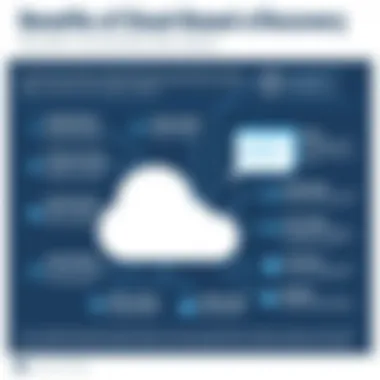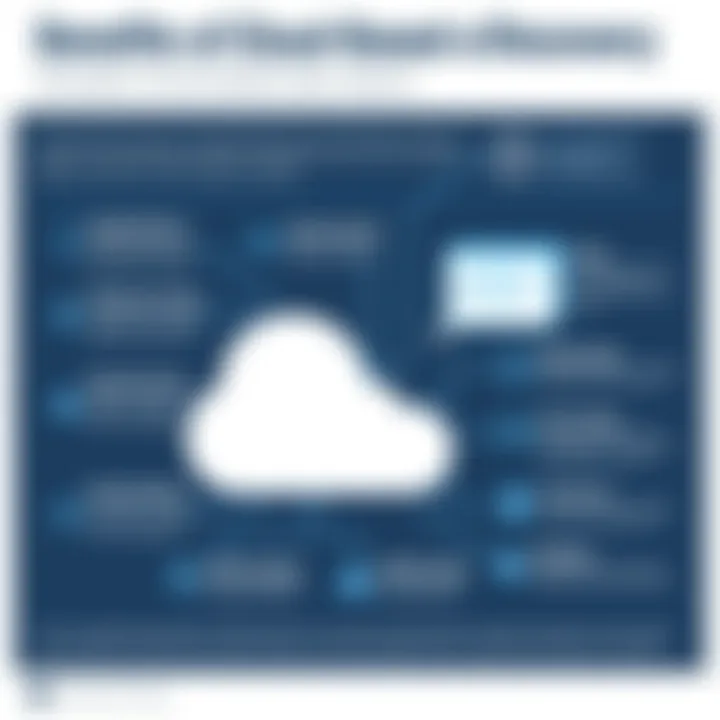Exploring Cloud-Based eDiscovery and Its Impact


Intro
Cloud-based eDiscovery has emerged as a pivotal component in the landscape of modern data management, especially within legal frameworks. In a world where data is not only abundant but also complex, leveraging cloud technology can be the difference between efficiently managing vast amounts of information or getting lost in it. As organizations increasingly rely on these digital solutions, understanding the intricacies of cloud-based eDiscovery becomes paramount. It brings forth an array of opportunities while simultaneously posing distinct challenges that professionals must navigate carefully.
With an eye on compliance and data retrieval, companies are now faced with the dual task of meeting legal requirements while promoting operational efficiency. As such, a deep dive into cloud-based eDiscovery is not just relevant; it’s essential for decision-makers, IT professionals, and entrepreneurs looking to streamline their processes.
This article will unpack the core elements of cloud-based eDiscovery, from defining its key features to exploring the myriad benefits and the legal implications entangled within. Readers can expect to discover implementation strategies and the emerging trends shaping this dynamic field. By the end, they should feel better equipped to engage with the complexities of adopting cloud technologies in their eDiscovery processes.
Let’s embark on this exploration, understanding how these cloud solutions redefine data handling in the digital age.
Foreword to Cloud-Based eDiscovery
In today’s fast-paced digital world, understanding the nuances of Cloud-Based eDiscovery stands as a pillar for legal and data management professionals. As organizations increasingly store data in the cloud, the traditional methods of data retrieval face significant transformations. Hence, grasping cloud-based eDiscovery is not just beneficial; it is crucial.
Defining eDiscovery
eDiscovery, or electronic discovery, is the process involved in identifying, collecting, and producing electronically stored information (ESI) for legal purposes. In simple terms, it’s the digital side of gathering evidence for lawsuits, audits, or investigations. Given the rise of digital communication and storage, eDiscovery has evolved beyond mere paper trails. When jurisdiction might hinge on emails, text messages, or social media posts, having a solid grasp of eDiscovery becomes paramount.
Overview of Cloud Computing
Cloud computing is more than just buzzwords thrown around in tech circles. It represents a shift in how businesses operate. By using servers hosted on the internet as opposed to local servers or personal computers, organizations can access and manage their data from virtually anywhere at any time. The flexibility, cost savings, and accessibility make it an appealing option for many. However, with these advantages come challenges, especially concerning data security and compliance with legal standards.
The Intersection of Cloud Computing and eDiscovery
Bridging cloud computing and eDiscovery invites a fresh perspective on data management. Organizations leveraging cloud solutions must adapt their eDiscovery strategies to retrieve relevant information effectively. For instance, cloud storage can streamline the collection process but raises questions about jurisdiction and data integrity. Furthermore, companies must be ready to navigate diverse data security measures, especially when working across international borders.
"Adopting cloud-based eDiscovery isn’t merely a choice; it’s a necessity in the modern legal landscape, as it aligns with where data is generated and stored."
In summary, the nuances of cloud-based eDiscovery require a nuanced understanding, as the implications of how data is stored and retrieved unfold. As we further explore this topic, the emphasis will remain on balancing opportunities and challenges while keeping compliance and best practices in focus.
Benefits of Cloud-Based eDiscovery
In an era where digital transformation shapes business processes, cloud-based eDiscovery stands out as a game-changer. It's not just a matter of convenience; the overall benefits it brings to organizations in managing legal data and compliance are substantial. Let's break down a few key advantages that make this approach both appealing and necessary for contemporary enterprises.
Cost-Effectiveness
When it comes to operating budgets, cloud-based solutions usually come out on top. Traditional eDiscovery can be an expensive and resource-intensive process. Implementing on-premises infrastructure for data storage, management, and analysis often requires significant upfront investments. In contrast, cloud-based eDiscovery operates on a subscription model, turning capital expenditure into predictable operational costs. This allows organizations to keep their balance sheets in check while allocating funds more effectively.
Moreover, utilizing the cloud means reduced IT overhead. Many tasks that would otherwise require teams of IT staff to manage can be handled seamlessly by the cloud providers. This means less time and money spent on maintenance, all while benefiting from cutting-edge technology.
Scalability and Flexibility
The beauty of cloud-based eDiscovery is in its flexibility. Organizations often find themselves with unpredictable data needs. Depending on the size of a case, the volume of data can fluctuate drastically. With cloud solutions, firms can scale their resources up or down as needed. This dynamic capability to adjust to changing demands is a lifesaver when dealing with the often chaotic world of eDiscovery.
For instance, if a large case unexpectedly hits, legal teams can quickly leverage additional storage or processing power without the hassle of lengthy procurement processes. Conversely, during quieter periods, they don’t have to pay for unused resources. This responsiveness not only enhances efficiency but also ensures that costs remain aligned with actual usage.
Enhanced Collaboration
In a field that requires input from various stakeholders—legal teams, IT departments, and sometimes even external consultants—effective collaboration is paramount. Cloud-based eDiscovery platforms foster seamless communication and teamwork. Unlike traditional methods where documents might be siloed away on local machines, cloud systems promote real-time access for authorized users, regardless of location.
For instance, a lawyer working in New York can access documents that a paralegal in San Francisco is modifying without any lag. Such connectedness leads to quicker decision-making and reduces the chance of miscommunication. As legal matters often have tight timelines, the benefits of enhanced collaboration through cloud-based eDiscovery cannot be overstated.
"In the modern legal landscape, being able to collaborate efficiently can mean the difference between winning and losing a case."
In summary, the benefits of cloud-based eDiscovery, from cost-effectiveness and scalability to enhanced collaboration, offer organizations a distinct advantage. By leveraging these cloud solutions, businesses position themselves to respond faster and smarter to the legal challenges of the digital age.


Challenges in Implementation
Implementing cloud-based eDiscovery is not a walk in the park. It's like trying to fit a square peg into a round hole at times. Organizations are enthused about the opportunities this kind of technology can offer but are often brought back down to earth by significant challenges that necessitate serious consideration. The stakes are high, as mishandling these challenges can lead to hefty fines, data leakage, and a loss of reputation. This section addresses the critical challenges organizations face when implementing cloud-based eDiscovery, including data privacy concerns, regulatory compliance issues, and the difficulties of integrating with legacy systems.
Data Privacy Concerns
To say data privacy is a hot-button issue these days is an understatement. With the rise of stringent regulations like the General Data Protection Regulation (GDPR) and the California Consumer Privacy Act (CCPA), businesses need to tread lightly. Data privacy concerns stem from the need to protect sensitive information during the eDiscovery process, often resulting from the careless handling of customer data. Companies must ensure that their selected cloud service providers implement robust security measures to safeguard this data.
Furthermore, organizations should invest time to:
- Conduct privacy impact assessments.
- Identify potential data breaches before they escalate.
- Create a data retention policy that aligns with consumer rights legislation.
This proactive approach can help avert potential issues that might arise in legal proceedings due to data mishandling.
"In the digital age, how we handle data speaks volumes about our organizational integrity."
Regulatory Compliance Issues
Navigating the stormy seas of regulatory compliance can feel like steering a ship without a compass. Different jurisdictions have distinct regulations that impact how eDiscovery can be performed, especially regarding cloud storage. For instance, while eDiscovery practices might be straightforward in one country, they could very well contravene regulations in another. Organizations need to stay abreast of these constantly evolving laws to remain compliant.
To ensure a smoother ride, businesses can implement:
- Regular compliance audits to assess adherence to applicable laws.
- Continuous education for staff on regulatory updates, minimizing risks of non-compliance.
- Relationships with legal experts who understand the legal landscape and can offer guidance.
Being out of synch with regulatory standards can not only result in financial penalties but can also damage a company's credibility in the eyes of clients and stakeholders.
Integrating Legacy Systems
Imagine trying to mix oil and water—this is akin to the challenge many organizations face when integrating legacy systems with new cloud-based eDiscovery tools. Many businesses still use older IT infrastructure, built at a time when cloud computing wasn’t even a thought in many IT departments. This disconnection can lead to compatibility issues that can complicate data retrieval, reduce efficiency, and create gaps in the data trail.
To ease this integration process, businesses should:
- Assess their current systems to determine compatibility with cloud solutions.
- Prioritize phased migrations where possible to prevent business disruptions.
- Develop a detailed integration plan and timeline to ensure a smooth transition.
By thoughtfully addressing these integration challenges, organizations can capitalize on the benefits of cloud-based eDiscovery while minimizing disruptions.
Navigating these challenges in implementation is crucial. Recognizing and addressing these issues not only fortifies the organization's infrastructure but also ensures better compliance, security, and operational efficiency as they embrace cloud technology.
Legal Implications of Cloud-Based eDiscovery
In the ever-evolving landscape of data management and legal proceedings, the legal implications of cloud-based eDiscovery hold significant importance. As organizations increasingly migrate to cloud environments, they confront a multitude of legal considerations that can profoundly impact their compliance and risk management strategies. Developing a robust understanding of these implications can not only help in risk mitigation but also position a firm advantage in legal disputes.
Understanding Legal Frameworks
Navigating the legal frameworks surrounding cloud-based eDiscovery is akin to trying to read a map in a foreign language. The intricacies of laws such as the General Data Protection Regulation (GDPR) and the Stored Communications Act introduce layers of complexity that businesses must unpack. These regulations outline how data can be collected, stored, and processed, which directly affects eDiscovery processes.
Organizations must ensure that their cloud providers comply with these frameworks, else they risk facing hefty fines and reputational damage. For instance, GDPR imposes strict guidelines on personal data processing, impacting how companies manage data across borders. Understanding which laws apply—as laws vary across regions—is crucial for ensuring a compliant eDiscovery process.
Case Law Influences
Case law significantly influences how cloud-based eDiscovery is practiced. Legal precedents established in landmark cases provide a roadmap for courts, legal practitioners, and organizations to follow. For example, in United States v. Microsoft Corp., the court addressed issues of data storage location and jurisdiction. The ruling emphasized that data, regardless of location, can be subject to U.S. laws.
Such case law not only impacts cloud service agreements but also dictates how organizations prepare their digital records for eDiscovery. Lawyers must stay informed about current rulings to effectively strategize around potential data vulnerabilities and prepare sound eDiscovery practices that align with judicial expectations.
"Understanding these legal precedents can help organizations mitigate risks and avoid costly missteps during litigation."


Strategic Considerations in Litigation
When it comes to litigation, cloud-based eDiscovery necessitates strategic planning from the outset. Decision-makers need to evaluate their cloud vendors not just for technology but for their legal compliance and security protocols. Factors worth considering include:
- Data Ownership: Who owns the data? Understanding this is vital in determining control over data and the implications for access during audits or litigation.
- Data Retrieval Speed: Proficiency in data extraction can be a game-changer. Fast retrieval not only saves time and money but can also provide a strategic advantage during legal disputes.
- Collaborative Tools: Involving lawyers early in the cloud selection process can help to ensure that the tools available facilitate seamless communication and data sharing, making it easier to respond to eDiscovery requests quickly and effectively.
Security Considerations
Security is a non-negotiable aspect of cloud-based eDiscovery. As organizations migrate to cloud infrastructures, they face numerous risks regarding data integrity, confidentiality, and availability. A robust security framework is essential to protect sensitive data from unauthorized access and potential breaches. The significance of this topic cannot be overstated, especially considering the evolving threat landscape in the digital age. Each of the subsections below delves into critical components of security that practitioners need to adopt and understand to navigate the complexities of cloud solutions effectively.
Data Encryption Mechanisms
One of the linchpins of securing data in the cloud is encryption. By transforming data into code, encryption renders it inaccessible to unauthorized entities. The importance of data encryption mechanisms is multifaceted. Firstly, it protects data at rest, meaning that even if a hacker gains access to the storage, they cannot read the information without the decryption key. Moreover, encryption safeguards data in transit, essentially securing communications that happen during data transfers. Modern encryption standards, such as AES-256, are widely recognized and utilized in cloud environments, providing a high level of security capable of resisting brute-force attacks. It’s essential for organizations to keep their encryption standards up to date, as weaknesses in algorithms can be discovered over time.
"Encryption is like locking your valuables in a safe – if implemented correctly, it ensures that they stay out of reach from prying eyes."
Access Control Measures
Implementing stringent access control measures is another fundamental strategy aimed at preventing unauthorized access. This involves creating user permissions that dictate who can see and interact with data. Role-based access control (RBAC) is one such approach. By assigning roles to users based on their job functions, organizations can effectively limit access. This principle of least privilege minimizes the risk of internal threats, where a disgruntled employee might exploit their access rights for malicious purposes. Multi-factor authentication (MFA) is another critical factor in access control. By requiring additional verification methods such as a text message or a biometric scan, you create an extra layer of defense that significantly reduces the risk of unauthorized access. Additionally, organizations should conduct regular reviews of user access rights to ensure that permissions remain appropriate as roles and responsibilities shift.
Regular Security Audits
Security can’t be a one-time effort; it needs continual assessment and enhancement. This is where regular security audits come into play. Audits serve to identify vulnerabilities and ensure compliance with internal policies and external regulations. They evaluate encryption practices, access control implementations, and data handling procedures, essentially providing organizations a clear picture of their security stature. A proactive approach to security audits often involves employing third-party services that can bring a fresh perspective and expertise that in-house teams might lack. Furthermore, adopting automated auditing tools can enable organizations to monitor and review security settings consistently. This continuous feedback loop not only helps in catching potential problems early but also fosters a security-aware culture within organizations.
In summary, security considerations are an integral backbone of cloud-based eDiscovery. Emphasizing data encryption, solid access control measures, and regular security audits ensures that an organization maintains a safe environment for its digital data, thus mitigating risks associated with cloud technologies.
Trends Shaping the Future of eDiscovery
In today’s rapidly evolving digital landscape, the future of eDiscovery is unmistakably intertwined with cutting-edge technologies. These advancements are not just about streamlining processes but fundamentally transforming how organizations manage data and navigate legal frameworks. Understanding these trends can assist decision-makers and IT professionals in making informed strategic decisions in their operations.
Artificial Intelligence in eDiscovery
Artificial Intelligence (AI) has planted itself firmly at the forefront of eDiscovery trends. Its significance lies in its ability to automate and expedite the discovery process. Utilizing AI algorithms can help sift through massive amounts of data efficiently and effectively. The benefits are numerous: faster data retrieval, reduced costs, and enhanced accuracy in identifying relevant documents. When AI systems analyze patterns, they not only save time but also minimize human error. Think of AI as a highly efficient, tireless employee sifting through mountains of digital paperwork.
Some specific applications include:
- Document Classification: Automating the categorization of documents based on content relevance.
- Keyword Analysis: Understanding the context for more accurate search results rather than just relying on surface-level keywords.
- Sentiment Analysis: Determining the underlying sentiment of communications or documents, which is crucial in litigation contexts.
In integrating AI with traditional eDiscovery processes, firms can drastically lower the burden on legal teams while improving outcomes.
Predictive Coding and Machine Learning
Predictive coding is another trend taking center stage. This method relies on machine learning to predict how a human might code a document. Essentially, it allows the technology to learn and refine itself during the process. As attorneys or reviewers categorize documents, the algorithm absorbs this information. The next batch of documents can then be categorized with greater accuracy and fewer resources.
The critical benefits include:
- Efficiency: Reducing the need for extensive manual review saves both time and costs.
- Scalability: Easily adjusting to the volume of data without a corresponding increase in resources.
- Quality Assurance: More consistent results due to the minimization of human biases and errors.
Organizations that adopt predictive coding are often quicker on their feet, able to adapt to changing regulations and discovering patterns in data that could go unnoticed without such technology.
Blockchain Technology Applications
Blockchain technology, often associated with cryptocurrencies, is also carving its niche within the realm of eDiscovery. The ability to maintain secure, tamper-proof records is appealing for legal sectors needing transparency and accountability.
The potential applications are numerous, including:


- Chain of Custody: Maintaining an indelible record of when and how data is accessed, ensuring compliance with legal requirements.
- Data Integrity: Confirming that documents have not been altered during the eDiscovery process.
- Smart Contracts: Automating certain legal agreements based on predefined criteria that can streamline workflows.
By integrating blockchain technology, organizations not only enhance the security of their data but also reinforce their legal positions through irrefutable records.
The End
Understanding these trends is paramount for any professional navigating the murky waters of cloud-based eDiscovery. Keeping pace with these advancements—like AI, predictive coding, and blockchain—can significantly shape an organization's approach to legal data management. As these technologies continue to evolve, their applications in eDiscovery will undoubtedly present new opportunities and challenges for legal professionals.
Best Practices for Implementing Cloud-Based eDiscovery
Implementing cloud-based eDiscovery successfully can be a game changer for organizations seeking to navigate complex legal landscapes and data management challenges. However, it is essential to approach this transition with a strategic mindset. The right practices can steer a company clear of pitfalls and enhance their eDiscovery process significantly.
Selecting the Right Providers
Choosing the right cloud service provider is akin to picking the right ship for an ocean voyage. You want to make sure it’s sturdy, reliable, and equipped for any weather conditions. This selection process should begin by evaluating providers’ security protocols, service levels, and compliance certifications. For instance, a provider that adheres to ISO 27001 standards not only demonstrates commitment to stringent security but also shows awareness of international best practices.
Additionally, it is highly beneficial to analyze their data recovery services and support responsiveness. Does the provider offer 24/7 support? How quickly can they recover lost data in the event of a malfunction? These queries ought to shape your decision-making.
Don’t skimp on due diligence; it can pay off majorly down the road.
Conducting Thorough Risk Assessments
Once a provider is selected, the next crucial step is conducting robust risk assessments. This involves scrutinizing not only the technical aspects, such as data loss potential and unauthorized access scenarios, but also legal and compliance issues that could arise from storing sensitive data in the cloud.
Consider making a checklist that includes points like:
- Data classification: Understanding what kind of data you have and its sensitivity level is key.
- Regulatory requirements: Be aware of regulations like GDPR and HIPAA that may impact your storage strategy.
- Potential vulnerabilities: Identify where the weaknesses lie, whether in the cloud architecture itself or in the processes used to manage the data.
Regular assessments help build a robust risk profile that guides your cloud eDiscovery strategy.
Creating a Response Plan
No one ever wants to find themselves in a tight spot, especially during legal proceedings. Therefore, having a well-crafted response plan in place is paramount. A responding plan should outline who does what when an incident occurs, ensuring that everyone knows their role in a crisis. This not only avoids confusion but also guarantees swift action, minimizing damage.
A good response plan might include the following:
- Incident communication protocols: Determine how to communicate incidents to key stakeholders.
- Data breach response: Outline step-by-step actions, from notifications to data recovery efforts.
- Review and revision schedule: Regularly revisit the plan to incorporate lessons learned from past experiences.
"Failure to plan is planning to fail." – This adage rings particularly true within the realm of eDiscovery. Without a solid response plan, organizations may find it hard to maneuver through crises relating to cloud-based data.
Each of these aspects—selecting the right providers, conducting thorough risk assessments, and creating a well-defined response plan—serves as foundational pillars that fortify the edifice of cloud-based eDiscovery. By implementing these best practices, organizations not only elevate their operational efficiency but also minimize risk exposure. As the landscape of eDiscovery continues to evolve, staying proactive will provide a significant advantage.
Finale
In wrapping up this exploration of cloud-based eDiscovery, it’s crucial to underscore the significance of understanding the interplay between cloud technologies and legal workflows. The rise of digital transformation in organizations has rendered eDiscovery practices not just a necessity but a strategic imperative.
Summarizing Key Insights
A few key takeaways certainly stand out:
- Adaptability to Modern Challenges: Cloud-based eDiscovery addresses the burgeoning volumes of data that organizations must navigate today. This adaptability can make data retrieval much more efficient, reducing the time and resources spent on discovery processes.
- Enhanced Collaboration: By utilizing cloud solutions, teams across various locations can work together seamlessly. This real-time collaboration not only speeds up processes but also enhances the quality of insights gathered during eDiscovery.
- Cost Savings: Transitioning to cloud-based solutions can lead to significant cost savings. Organizations often notice a reduction in IT infrastructure expenses and maintenance when leveraging cloud resources.
Reflecting on these points paints a picture of a landscape where cloud-based eDiscovery is not merely a trend but an evolution in the field.
Future Directions for Cloud-Based eDiscovery
Looking ahead, the trajectory of cloud-based eDiscovery appears promising, marked by several emerging trends:
- Integration of Advanced Technologies: As artificial intelligence and machine learning continue to advance, their incorporation into eDiscovery could lead to even smarter data management solutions. Expect to see predictive analytics play a more significant role in identifying relevant data.
- Increased Regulations: As data privacy laws evolve, companies will need to stay ahead. This mandates a robust compliance strategy that can adapt to new legal challenges presented by cloud technologies.
- Greater Focus on Security Innovations: With security concerns always looming, investment in advanced security technologies will likely skyrocket. Measures such as end-to-end encryption and more sophisticated access controls are becoming the norm.
Moving forward, decision-makers must remain vigilant and proactive, ensuring their organizations harness these cloud-based eDiscovery strategies effectively while addressing any inherent challenges. With the right tools and frameworks, organizations can position themselves at the forefront of innovation in legal data management.















